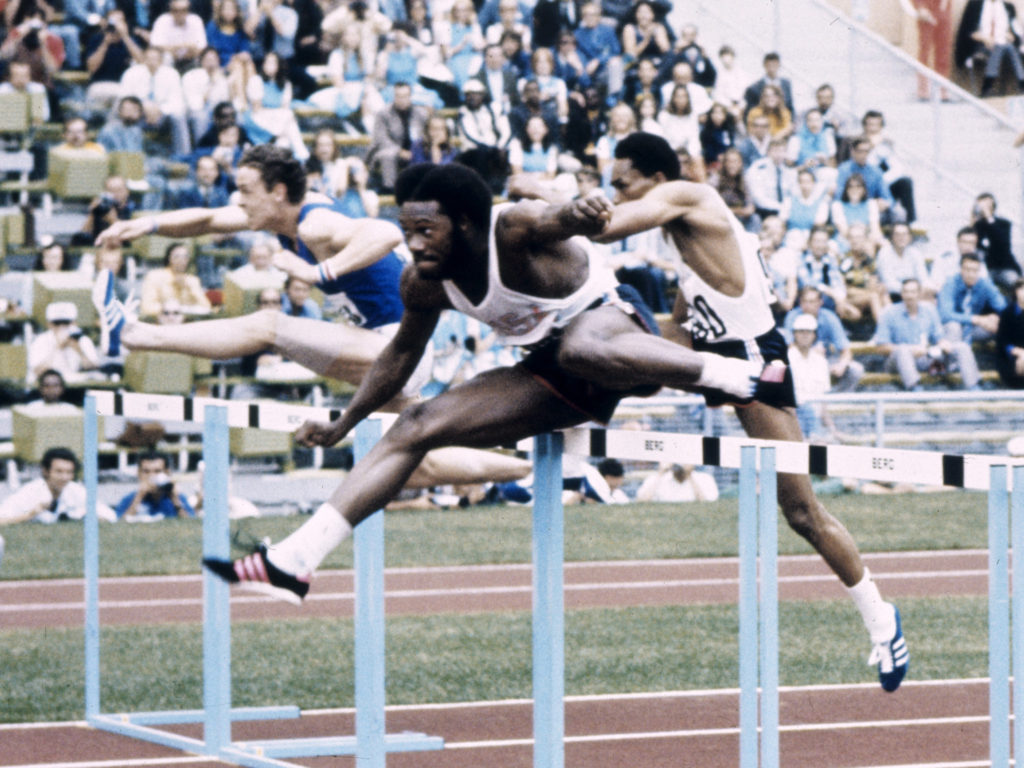
Rodney Milburn
Sport: Track and Field
Induction Year: 1988
University: Southern
Induction Year: 1988
As a child, Rodney Milburn couldn’t participate in athletics. “I had asthma read bad until I was about 10 years old,” Milburn recalled. “I couldn’t participate in anything because of a shortness of breath. It was very frustrating.”
When a combination of growth and medication took care of his problem, Milburn decided to become a hurdler. But his coach at J.S. Clark High in Opelousas, Claude Paxton, didn’t know about it.
“I was training him to be a sprinter,” said Paxton. “But he was going out on his own and running the hurdles on a grass track behind the school. “One day, we needed a hurdler, and Rodney told me he thought he could run the hurdles. I put him in there with my top hurdler, and Rodney beat him.”
In 1968, Milburn had the fastest times in the state as a junior – 13.9 seconds in the 120-yard high hurdles and 19 seconds flat in the 180-yard low hurdles.
Milburn cleared some barriers and broke others.
He and Spencer Thomas of Carver (New Orleans) were two of 12 athletes at all-black Louisiana Interscholastic Athletic and Literary Organization schools who were selected on the Louisiana Sports Writers Association All-State track and field team that year. It was the first time LIALO athletes were recognized by the LSWA in any sport. Two years later, when Louisiana public schools were integrated, the LIALO was disbanded.
In his senior year, running on the same grass track where he learned to hurdle without his coach’s knowledge (going from one goal post to the other on a football field), Milburn broke the national record in the 120-yard high hurdles with 13.5
This time, he shared “Outstanding Track Man” honors on the LSWA All-State team with record-breaking miler Bobby Sahaque of Redemptorist (New Orleans). Another LIALO athlete made history that year when Charles Stewart, a sprinter at Shreveport’s Booker T. Washington High, became the first black athlete to sign a letter of intent with LSU in any sport.
Southern University in Baton Rouge was the next stop for both Milburn and his coach, Paxton. There, he quickly developed into a world class hurdler.
Among the world records he set were (indoors) 5.8 in the 50-yard hurdles, 6.8 in the 55-meter hurdles, 6.7 in the 60-yard hurdles and 13.3 in the 120-yard hurdles and (outdoors) 13 seconds flat in the 120-yard and 110-meter hurdles.
The record he cherished the most was his 13 flat in the 1971 National AAU semifinals at Eugene, Oregon. It was the first time Milburn or anybody else did it without the benefit of a tailwind.
Thirteen was a lucky number indeed for Milburn, who proved it was no fluke by running 13 flat on 13 occasions during his career.
“I got so comfortable running the hurdles, it was just like a ballet going out there and going through the routines,” he said.
In 1970 and 1971, he won 78 consecutive races and was selected the World’s Outstanding Athlete in 1971. That year, and again in 1973, Milburn broke another barrier by winning the Jim Corbett Memorial Award as the outstanding amateur athlete in Louisiana. He was the first black winner.
Although he was two-tenths of a second faster than anybody else in the world, Milburn nearly blew his chance for a berth on the United States team in the finals for the 1972 Olympic Trials.
He hit two hurdles, and barely qualified in third place.
One of the men who finished ahead of him in that race was another Southern University product, Willie Davenport. In 1968, when Milburn was a junior at J.S. Clark High, Davenport set the Olympic record in winning the gold medal at the Mexico City Games. In 1964 long before Milburn ran his first hurdles race, Davenport was the surprise winner of the U.S. Olympic Trials, but wasn’t able to survive the semifinals of the Tokyo Games because of a leg injury.
In the 1972 Munich Games, Milburn and Davenport faced stiff competition from Guy Drut of France. This time, however, Milburn didn’t hit any hurdles. He was the first man to reach the first flight of hurdles, and led by nearly two meters at the sixth flight. He lowered the Olympic record to 13.24 seconds, holding off a fast-closing Drut by one meter to win the gold medal.
The time was a ho-hum 13.1 seconds, but one of Milburn’s most satisfying victories came in the 1973 NCAA championships at LSU’s Bernie Moore Stadium. Although Milburn’s Baton Rouge apartment was only two blocks away from Bernie Moore Stadium, one of the world’s finest facilities, he had never been allowed to train there because the track was reserved for LSU students.
Milburn was ranked No. 1 in the world three years in a row, from 1971 through 1973. After competing professionally in the International Track Association and playing football for the Shreveport Steamer of the World Football League, Milburn and other ITA athletics tried to regain their amateur status for the 1976 and 1980 Olympics. The International Amateur Athletic Federation finally restored their eligibility in 1980, but specified they could not participate in the Olympic Trials or Olympic Games. It turned out to be a moot point, because President Jimmy Carter didn’t allow the United States to participate in the Moscow Olympics because of Russia’s invasion of Afghanistan.
It provided a final irony for Milburn’s career. As a child, he wasn’t allowed to participate in athletics because of asthma. At the peak of his hurdling career, he wasn’t allowed to compete in the Olympics because of politics.
He competed until the age of 33, when he was still fast enough to be clocked at 13.34 seconds.










